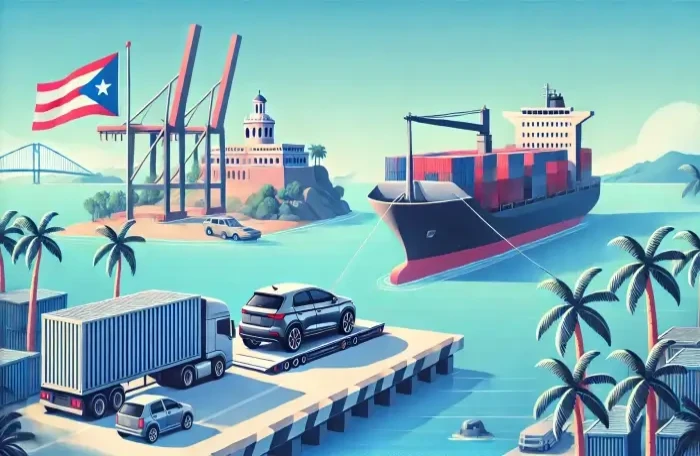Complete Guide to Shipping a Car to Puerto Rico: Important Steps and Insights

Lila Claybourne
Sep 16, 2024

Summary:
Introduction: Understanding the Process
Cost Considerations and Factors
Detailed Steps to Ship Your Car
Preparing Your Car for Shipment
Comparing Shipping Methods
Environmental Impact
Legal and Regulatory Considerations
Insurance Considerations
Cost-Saving Tips
Post-Arrival Checklist
Common Challenges and Solutions
FAQs
Conclusion: Is This the Right Choice for You?
Understanding the Process
Shipping a car to Puerto Rico involves transporting your vehicle over both land and sea, requiring coordination between various carriers and adherence to specific regulations. As Puerto Rico is a U.S. Commonwealth, the regulatory differences are minimal compared to other international shipments, but the process still demands careful planning and preparation.
Cost Considerations and Factors
Shipping a car to Puerto Rico involves several cost factors that can significantly affect the total expense. Here's an expanded look at these factors:
1. Distance: The distance between your location and the port greatly impacts the shipping cost. For instance, shipping from New York to Puerto Rico is typically cheaper than shipping from California due to the shorter distance.
Example: Shipping a standard vehicle from New York might cost around $2,100, while from California, it could be up to $3,300.
2. Vehicle Size and Type: Larger vehicles like SUVs or trucks incur higher shipping costs compared to compact cars.
Example: Compact cars might cost around $1,200 to ship, whereas SUVs can cost up to $3,300 due to their size and weight.
3. Transport Method: Options include Roll-on/Roll-off (RoRo), enclosed containers, and air freight. RoRo is the most economical but exposes the vehicle to the elements. Enclosed containers offer better protection at a higher cost, while air freight is the fastest and most expensive.
4. Season and Timing: Prices can vary based on the time of year and carrier availability. Shipping during peak seasons or holidays can be more expensive due to higher demand.
5. Pickup and Delivery: Choosing door-to-port and port-to-door services adds to the overall cost. Opting for door-to-door service can increase convenience but also the price.
Detailed Steps to Ship Your Car
Choose a Shipping Method:
RoRo: Your car is driven onto the ship and secured in the cargo area. It's cost-effective but exposes the vehicle to the elements.
Enclosed Container: Offers better protection for high-value vehicles. More expensive than RoRo.
Air Freight: Fastest and safest but the most costly option.
Gather Required Documents:
Certificate of Conformity from the EPA (if applicable)
Valid driver’s license
Proof of ownership and registration
Proof of payment for the Excise Tax.
Book Your Shipment: Arrange with a reputable shipping company. Ensure they handle both the land transport to the port and the sea transport to Puerto Rico.
Prepare Your Vehicle:
Clean the exterior and interior.
Remove all personal items.
Document the car’s condition with photos.
Ensure the fuel tank is no more than a quarter full.
Drop Off and Pickup:
Drop off your car at the designated port or have it picked up by the shipping company.
On arrival in Puerto Rico, clear customs, pay any remaining fees, and retrieve your vehicle.
Preparing Your Car for Shipment
Properly preparing your car for transport is crucial to ensure it arrives in the same condition it was in before shipping. Here are the steps you should take:
Remove Personal Items: Although some companies may allow you to pack belongings in your car, it's wise to remove valuables and important documents to avoid any potential loss.
Check Tires and Battery: Ensure your tires are inflated and the battery is charged to avoid issues when picking up your car.
Disable Alarms: Deactivate any security alarms to prevent them from going off during transit.
Clean and Inspect: Wash your car and take detailed photos of its condition, noting any pre-existing damage.
Fuel Level: Keep your fuel tank less than a quarter full to reduce weight and comply with safety regulations.
Checklist for Preparation:
Clean car interior and exterior.
Remove all personal items and valuables.
Check and inflate tires.
Charge battery.
Disable alarm systems.
Document car’s condition with photos.
Ensure the fuel tank is less than a quarter full.
Comparing Shipping Methods
RoRo vs. Enclosed Container vs. Air Freight:
RoRo (Roll-on/Roll-off):
Pros: Most cost-effective, straightforward process.
Cons: Vehicles are exposed to weather and potential damage during transit.
Ideal For: Standard vehicles where cost savings are a priority.
Enclosed Container:
Pros: Provides maximum protection from weather and potential damage, suitable for high-value vehicles.
Cons: More expensive than RoRo, longer processing time.
Ideal For: Luxury, classic, or high-value cars where protection is essential.
Air Freight:
Pros: Fastest shipping method, highest level of security and protection.
Cons: Extremely costly, limited availability.
Ideal For: Urgent shipments or highly valuable vehicles where cost is not a constraint.
Environmental Impact
Detailed Analysis: Shipping methods vary significantly in their environmental impact. Here’s a closer look:
RoRo: Generally, RoRo shipping has a lower carbon footprint compared to air freight due to the efficiency of sea transport. Ships can carry many vehicles at once, reducing per-vehicle emissions.
Enclosed Container: Similar to RoRo in terms of sea transport but may have a slightly higher environmental impact due to the added weight and space of containers.
Air Freight: Significantly higher carbon footprint. Airplanes consume large amounts of fuel, and emissions per vehicle are considerably higher compared to sea transport.
Statistics: According to the Environmental Protection Agency (EPA), sea transport emits approximately 3-4 times less CO2 per mile compared to air transport. Shipping by sea is a more sustainable choice for long-distance vehicle transport.
Legal and Regulatory Considerations
Customs Regulations: Shipping a car to Puerto Rico involves adhering to customs regulations. Key steps include:
Documentation: Ensure you have all required documents, such as proof of ownership, registration, and a Certificate of Conformity from the EPA.
Customs Clearance: Upon arrival, your vehicle must clear Puerto Rican customs, which involves inspection and verification of documents.
Excise Tax Details:
The excise tax in Puerto Rico is calculated based on the vehicle’s value, make, model, and year. Payment can typically be made online through the SURI portal before or upon arrival.
Local Laws and Registration:
After your vehicle arrives, you have three days to register it with Puerto Rican plates. This involves:
Visiting the DTOP (Puerto Rico’s DMV) office.
Submitting the title, proof of residency, and other necessary documents.
Paying the registration fee, which varies based on the vehicle's weight.
Insurance Considerations
Shipping Insurance:
It’s crucial to understand what type of insurance is available and recommended when shipping your car:
Basic Coverage: Most shipping companies include basic coverage in their services.
Comprehensive Insurance: For added protection, especially for high-value vehicles, consider purchasing additional coverage from recommended providers.
Transit Insurance:
Verify if your existing car insurance covers international transit. Often, additional insurance may be needed to cover the transport period comprehensively.
Cost-Saving Tips
Discounts and Deals:
Look for shipping companies offering discounts, especially during off-peak seasons.
Check for promotional offers or loyalty programs that could lower costs.
Group Shipments:
Shipping multiple cars together can reduce costs. Coordinate with friends or family to arrange a group shipment.
Some companies offer discounts for bulk shipping arrangements.
Post-Arrival Checklist
Inspection and Documentation:
Upon your car’s arrival in Puerto Rico:
Conduct a thorough inspection for any damage.
Compare the car’s condition with the photos taken before shipment.
Ensure all required documents are in order for customs clearance.
Local Services and Support:
Utilize local services to get your car ready for use:
Find a reputable mechanic for any necessary maintenance.
Use local car washes and detailing shops to clean and prepare your vehicle.
Common Challenges and Solutions
Potential Issues:
Delays: Shipping schedules can be affected by weather or logistical issues. Stay in regular contact with your shipping company for updates.
Damage: If your vehicle is damaged during transit, document the damage and contact the shipping company immediately to file a claim.
Customer Support:
Understand the customer support process of your shipping company. Know whom to contact and what to expect in terms of response time and issue resolution.
Making an Informed Decision for Shipping Your Car to Puerto Rico
Shipping a car to Puerto Rico is a complex process that requires careful consideration of various factors, including costs, shipping methods, documentation, and legal requirements. By understanding the steps involved and preparing your vehicle and paperwork in advance, you can ensure a smooth and successful shipment.
Whether you're relocating, sending a vehicle to a loved one, or simply exploring the possibility of owning a car in Puerto Rico, this guide provides the essential information you need to make an informed decision. With the right preparation and a trusted shipping partner, your car will arrive safely in Puerto Rico, ready for your next adventure on the island.
FAQs
1. How much does it cost to ship your car to Puerto Rico? The cost typically ranges from $1,200 to $3,300 depending on the shipping method, distance, and vehicle size.
2. Can I buy a car in the US and bring it to Puerto Rico? Yes, you can purchase a car in the US and ship it to Puerto Rico. Ensure you have all necessary documentation, including proof of ownership and a Certificate of Conformity if applicable.
3. How much is vehicle import tax in Puerto Rico? Import tax varies based on the vehicle's value, make, model, and year. Typically, you need to pay an excise tax upon arrival in Puerto Rico.
4. Who ships cars to Puerto Rico? Several companies, including Crowley, ShipLux, and Puerto Rico Car Transport, specialize in shipping cars to Puerto Rico.
5. Why are cars in Puerto Rico so expensive? Cars in Puerto Rico can be more expensive due to import taxes, shipping costs, and the limited supply compared to the mainland US.
6. Is shipping to Puerto Rico more expensive? Shipping to Puerto Rico can be more expensive than domestic shipping due to the additional sea transport and associated costs.
7. Are cars cheaper in Puerto Rico? Generally, cars tend to be more expensive in Puerto Rico due to import taxes and shipping costs.
8. What is the cheapest way to ship to Puerto Rico? The most cost-effective method to ship a car to Puerto Rico is using the Roll-on/Roll-off (RoRo) service.
10. How do I import a car into Puerto Rico? Importing a car involves selecting a shipping method, gathering required documentation, booking the shipment, and clearing customs upon arrival.
11. What is the most common car in Puerto Rico? The most common cars in Puerto Rico tend to be compact and mid-sized vehicles, with brands like Toyota and Honda being particularly popular
Related Posts
















